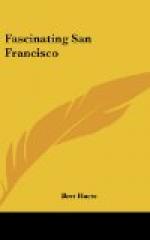Perhaps when Bret Harte referred to San Francisco as “serene, indifferent of Fate,” he was thinking of Sidney Smith’s declaration:
“Fate cannot harm me—I have dined today!”
When you think of eating in San Francisco you think of bright lights and dancing. In addition to the hotels, you may dance at innumerable cafes. Influences of Old Spain dowered San Francisco with an infatuation for the fiesta. The city has always been dance-minded. Art Hickman, virtuoso of jazz orchestration, was called to New York to have the Follies on The Roof dance to the exuberant strains he had evolved in San Francisco. Patterns of new dance forms were derived by Pavlowa from the wild rhythms she found on the old Barbary Coast.
The Palais Royal, Marquard’s, Tait’s-at-the-Beach, the Cliff House—but where is one to stop when he starts to name the San Francisco cafes that attract dance crowds? Let’s leave it to the classified lists in the telephone directories.
Hotels
Wives and daughters of the men who awoke to find themselves millionaires in the days of the Argonauts came to San Francisco to explore the social thrills of the newly rich. It is easy to understand why the hotels became the scenes of elaborate gaiety unmatched even in New York, Boston or the older communities. Haunts of the battling giants of the Comstock mines and the railroad magnates, the old Palace, Occidental, Lick and Baldwin hotels reflected their effulgent period.
The Palace, built by William C. Ralston, has survived as a landmark of San Francisco. Like Shepheard’s in Cairo, the Palace is one of the gathering places of the traveling world. The present hotel, at Market and New Montgomery streets, occupies the site of the old Palace, whose outer walls remained standing after the fire of 1906 and had to be blasted with dynamite to make room for the new structure—a tribute to the original builders. The Palace retains the outstanding aspects of the old hotel, with added modern appointments. The Palm Court, which has decorative columns and a glass-domed roof, is the social center of the hotel. It is also the rendezvous of the political and business stalwarts of the city, the Palace being a clearing-house for diversified activities. The Rose Bowl, which has Maxfield Parrish’s Pied Piper of Hamelin, attracts the set that dances when it dines.
Perched like a Parthenon on Nob Hill, the acropolis of San Francisco, is the Fairmont Hotel commanding a view of the Bay and the Contra Costa hills. Its Venetian Room, its Terrace and its Ball Room are among the features of the Fairmont in keeping with its individual environment. Expansive lawns frame the Renaissance architecture of the building, which seen from the Bay looks like a citadel inside the Golden Gate.




